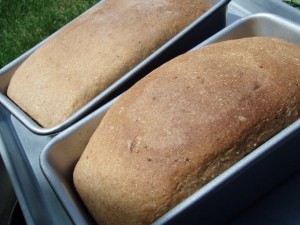 While the topic may sound a bit “ho hum” I assure you that if you’ve ever made bread—successfully or not—you will benefit from this these vital bread making tips.
While the topic may sound a bit “ho hum” I assure you that if you’ve ever made bread—successfully or not—you will benefit from this these vital bread making tips.
Last night I took a little “me time” and attended a bread making class. I love to see how other folks do things and I always hope to learn something to “sharpen my saw” along the way as well. I’m happy to say the time spent was well worth my while and a successful addition to my Mental Preparedness aspect. However, while I was sitting there and listening to the instructor, I realized that I’ve never addressed some of the nuances of bread making in my articles, and to be frank, I discovered these little “secrets” are what makes or breaks a successful loaf of bread for me.
Bread Making is a Vital Skill
Before I go on, allow me to share with you why bread making is a vital skill everyone should have. To be perfectly honest, I used to think that learning how to make bread would put me in some antiquated category of a Mrs. Cleaver housewife that I could never relate to. In some respect, I thought if I was ever “one of those women” who made my own bread, I would also be the same woman who had 12 kids, a house that always smelled like dirty diapers who ate things like canned pickled beets for dinner. (I loathe beets, just FYI) In other words, for some dumb reason I thought I’d lose my unique identity as a “modern-day woman” if I embraced making my own bread. I’m happy to say that I was WAY wrong in those notions.
 Making bread today has come a LONG way from when your grandma made it. I can make a loaf of bread from flour to fragrant in about 75 minutes total—including rising time thanks to today’s technological advances. Additionally, making my own bread increases my mealtime buying power easily by 400-500%! With one recipe I can have a couple loaves of bread, cinnamon rolls, an apple cinnamon breakfast braid, pizza dough, as well as some scones for Navajo Tacos and spend only a small fraction of cost for EVERYTHING that I would if I had to buy all of the ready-made processed stuff. Not the least of importance, storing wheat is a bit senseless and expensive if you don’t know how to use it, right? Wheat may be the cheapest form of food that will store long term, but that doesn’t mean a hill of grains if I can’t do anything with it that my family will eat. So I consider knowing how to take that same wheat and make yummy foods just as important as buying and properly storing the wheat in the first place. So, here are a few vital bread making tips for you to help your bread making experience more successful.
Making bread today has come a LONG way from when your grandma made it. I can make a loaf of bread from flour to fragrant in about 75 minutes total—including rising time thanks to today’s technological advances. Additionally, making my own bread increases my mealtime buying power easily by 400-500%! With one recipe I can have a couple loaves of bread, cinnamon rolls, an apple cinnamon breakfast braid, pizza dough, as well as some scones for Navajo Tacos and spend only a small fraction of cost for EVERYTHING that I would if I had to buy all of the ready-made processed stuff. Not the least of importance, storing wheat is a bit senseless and expensive if you don’t know how to use it, right? Wheat may be the cheapest form of food that will store long term, but that doesn’t mean a hill of grains if I can’t do anything with it that my family will eat. So I consider knowing how to take that same wheat and make yummy foods just as important as buying and properly storing the wheat in the first place. So, here are a few vital bread making tips for you to help your bread making experience more successful.
Kellene’s Vital Bread Making Tips:
Vital Bread Making Tip #1:
It’s best to start out with freshly ground wheat, that way the nutrition and glutens are alive and frisky. Frisky glutens make for softer bread.
Vital Bread Making Tip #2:
SAF Yeast is my yeast of choice because is it isn’t coated with that additional coating that other yeasts are. As a result, I throw the yeast directly into my bread ingredients without having to proof it first. Also, I have successfully stored this kind of yeast for 10 years in my cool, dry pantry without any problems using it for bread. Once I open the package I put it in the freezer and simply scoop out whatever I need for my recipes directly from there. There’s no need to let it warm to room temperature. Also, you don’t have to measure with exactness when you’re putting your yeast in. I always use HEAPING spoonfuls of yeast. And if I know that I’m going to be freezing the dough for a while, I use even a bit more yeast. (Yes, this means that you never have to buy that frozen stuff again.)
Vital Bread Making Tip #3:
The kind of oil that you use in your bread really doesn’t make a bit of difference. It’s up to you. If you want to use cold-pressed coconut oil or vegetable oil—it doesn’t matter (although if I were you, I’d read my article on the types of oil that are best for you). You can use liquid soy lecithin for additional health benefits, or you can use lecithin granules. Either of these will store for YEARS on a cool, dry shelf and will last quite a while.
Vital Bread Making Tip #4:
Dough enhancer makes your bread dough happy. Dough enhancer contains a little more yeast, some vitamin C, some more gluten, and a few other great vitamins. Yeast LOVES vitamin C. And if 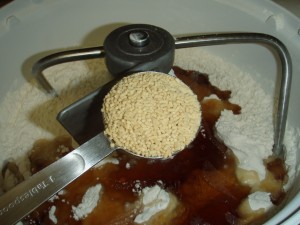 your yeast is happy, so is your bread. I always include some dough enhancer in my bread. Even when I make the 100% whole wheat bread, it’s not heavy and hard. My father-in-law still thinks I’m fibbing to him when I bring him a big fluffy loaf of 100% whole wheat bread. He swears that it’s white flour and is still not sure that I really make it my own home. 🙂 I think he may secretly believe I buy bread commercially made, zap it in the microwave and wrap it in foil before bringing him some. 🙂
your yeast is happy, so is your bread. I always include some dough enhancer in my bread. Even when I make the 100% whole wheat bread, it’s not heavy and hard. My father-in-law still thinks I’m fibbing to him when I bring him a big fluffy loaf of 100% whole wheat bread. He swears that it’s white flour and is still not sure that I really make it my own home. 🙂 I think he may secretly believe I buy bread commercially made, zap it in the microwave and wrap it in foil before bringing him some. 🙂
Vital Bread Making Tip #5:
Vital Wheat Gluten is overrated. Really. As long as you’re grinding your flour fresh, you’ll never need to use vital wheat gluten. As you may recall, I do use vital wheat gluten. But that’s to make wheat meat/seitan with. Not to use in my bread.
Vital Bread Making Tip #6:
When you’re putting yeast and salt in the initial dry ingredients, don’t put the two on top of each other. Give them their own side of the bowl. Yeast doesn’t like being bullied by the salt in a naked fashion. When you initially mix the dry ingredients together it’s fine because then both the salt and the yeast have the flour as a shield for them.
Vital Bread Making Tip #7:
When dividing your dough into loaves, rolls, or what have you, don’t pull it apart. You need to either pinch it or cut it. The reason is that you need to give the live gluten clusters a clean break in order for them to stay intact. If you pull them apart, you are essentially leaving some of the clusters in shreds rather than contained.
Vital Bread Making Tip #8:
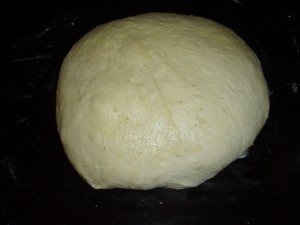 A lot of folks simply add too much flour. When you’re rolling out your dough or separating it, or handling it, DON’T use flour on your counter or your hands. Use a non-stick spray instead. When you’re initially mixing your bread dough, within the first few kneads (rotations of the blade) you should see a few “peaks” topped with flour. If you do, it’s perfect. If you have a lot of “peaks” topped with flour then you need more water. If you have no “peaks” topped with flour then you need to add about another quarter cup of flour. Too much flour makes for an unpleasant baked good.
A lot of folks simply add too much flour. When you’re rolling out your dough or separating it, or handling it, DON’T use flour on your counter or your hands. Use a non-stick spray instead. When you’re initially mixing your bread dough, within the first few kneads (rotations of the blade) you should see a few “peaks” topped with flour. If you do, it’s perfect. If you have a lot of “peaks” topped with flour then you need more water. If you have no “peaks” topped with flour then you need to add about another quarter cup of flour. Too much flour makes for an unpleasant baked good.
Vital Bread Making Tip #9:
You can use sugar or honey or agave or whatever sweetener you choose in your bread recipe. It really doesn’t matter on a scientific level. However, honey has its own little “powers” so to speak. So if you’re going to use honey, add it in AFTER you’ve mixed your dry ingredients together.
Vital Bread Making Tip #10:
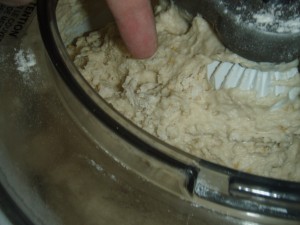 I used to be afraid that I would get the water in a recipe too hot or too cold and it sure seemed like a pain in the fanny to have to test it with a thermometer all the time. So here’s a simple rule. If you can put your finger into the water and hold it there without it burning, it’s not too hot for the yeast. You will kill your yeast if your water is too hot. But on the other hand, your yeast needs heat to develop. So bring on the hot water. But just be sure you test it with your finger first.
I used to be afraid that I would get the water in a recipe too hot or too cold and it sure seemed like a pain in the fanny to have to test it with a thermometer all the time. So here’s a simple rule. If you can put your finger into the water and hold it there without it burning, it’s not too hot for the yeast. You will kill your yeast if your water is too hot. But on the other hand, your yeast needs heat to develop. So bring on the hot water. But just be sure you test it with your finger first.
Vital Bread Making Tip #11:
You don’t need to wait for a long time for your bread dough to rise. When you begin making your bread, turn your oven on to 200 degrees. This level of heat should be just hot enough, but not so hot that you can’t touch that rack in your oven with your bare hand. When you’ve put your bread dough in whatever pan you’re baking it in, put it in that warm oven. Then turn the heat off and wait for it to rise until your dough is double in size. There’s no need for towels, plastic wrap, or anything else like that. Once it’s doubled in size then turn your oven back on to 350 degrees and bake it until it’s golden brown.
Vital Bread Making Tip #12:
Remember, you’re not just making bread dough, folks. You are making a  great dough for scones, rolls, doughnuts, bread sticks, cinnamon rolls, calzones, pizzas, and even tortillas. Feel free to get creative with your dough. You can roll it out flat into an oblong shape, put your favorite filling down the middle and then bring in the sides in a braided look or just roll it up and have all kinds of yummy meals. (Ideas: broccoli, chicken and cheese, apple or cherry pie filling, pizza fixings, taco fixings, etc. etc. etc.)
great dough for scones, rolls, doughnuts, bread sticks, cinnamon rolls, calzones, pizzas, and even tortillas. Feel free to get creative with your dough. You can roll it out flat into an oblong shape, put your favorite filling down the middle and then bring in the sides in a braided look or just roll it up and have all kinds of yummy meals. (Ideas: broccoli, chicken and cheese, apple or cherry pie filling, pizza fixings, taco fixings, etc. etc. etc.)
Vital Bread Making Tip #13:
My favorite bread making tool of all time is my Bosch mixer. It’s run with a bona fide MOTOR, not belts and such. The warranty on it has a “transmission” warranty—not some cheap plastic parts. I’ve had mine for over 10 years, and I know several homes that have had and used theirs for 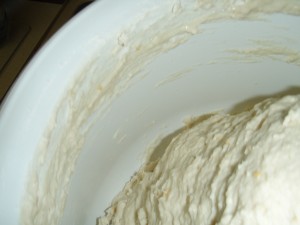 over 25 years. One single revolution of the Bosch mixer is like kneading your dough and turning it over four times. The dough hooks may look like they are just pushing the dough around, but they are indeed grabbing it and rotating it. As a result, I initially mix my dough for about 1 minute and then check for the small “flour peaks.”
over 25 years. One single revolution of the Bosch mixer is like kneading your dough and turning it over four times. The dough hooks may look like they are just pushing the dough around, but they are indeed grabbing it and rotating it. As a result, I initially mix my dough for about 1 minute and then check for the small “flour peaks.”
After that I mix/knead it in the Bosch for an additional 7 to 8 minutes. The first 5 or 6 rotations are going to tell me that I did it right as the dough will come cleanly away from the sides of the bowl. Yes, I realize a Bosch mixer won’t do me much good if there’s a prolonged power outage. But my husband is officially addicted to my bread and has assured me that if there’s  a way, he will allow us to use our minimal battery power to operate our Bosch mixer for the 8 to 10 necessary minutes. (How gallant of him, right? :))
a way, he will allow us to use our minimal battery power to operate our Bosch mixer for the 8 to 10 necessary minutes. (How gallant of him, right? :))
For my original 100% whole wheat bread recipe, check out this previous article. And enjoy. I’ve suddenly got the urge to make some more bread!



38 Comments
Houstonmom · December 3, 2009 at 10:59 pm
These are excellent tips. Thanks so much. I’ve never used lecithin granules. Do these last a long time in storage and are they good to have in your long term supply?
Kellene · December 3, 2009 at 11:10 pm
Yes, the granules last a good long time in a cool dry place.
Jen · December 4, 2009 at 12:36 am
Kellene ~ this is great! Thanks for sharing your expertise – you’ve saved me a lot of time.
jamie · December 4, 2009 at 12:56 am
Being disabled my tool of choice is the Kitchemaid mixer. My hints:
1. If you are not used to whole wheat products you can mix 1/2 white and wheat flour for almost any Yeast bread recipe. This will get your body used to Whole wheat.
2. A lot of recipes call for a “punch down” of dough after the 1st rise. Don’t punch your bread. Put on a counter top and use your knuckles to distribute the the rising/bubbles throughout the dough.
3. Place a pan of water, I use an old broiler pan, bottom rack with around 4 cups of water in the oven if you want softer crusts when the bread is cooled.
4. The first few times you may have some failures. You get good at baking bread and doughs by doing it. After a few times you will find that you can tell a good dough by the raw texture and smell.
5. I have found that using butter results in a slightly darker crust. Compared to some oils or margarine. Not bad, not burnt just slightly darker.
6. Always make at least 2 loaves. When bread comes out of the oven it’s irresistible.
7. Bagels and Pretzels are very similar recipe just google it. You just boil some water and drop them in and flip around 2 min each side. Just make the holes big enough. Homemade Lox and bagels can’t be beat.
8. After doing my own homemade breads. I can’t buy store breads anymore. It’s fresh, taste better and costs about .30 cents a loaf.
9. If you are using “Kosher Salt” use about a 1/2 teaspoon less than most recipes call for unless they specify Kosher Salt.
I’m now learning “Artisan” and no knead breads.
Kellene · December 4, 2009 at 10:43 pm
I have LOVED learning how to make Artisan breads. It’s such a GREAT world that keeps me highly entertained.
Just food for thought Jamie, the Kitchenaid mixers have 475 watts, whereas the Bosch have either 600 on an older model or 800 on anything purchased recently. This gives me a bit more piece of mind for long term use. Also, the hand crank that I can use on the Bosch in the event of a lack of electricity is amazing. So, when your Kitchenaid mixer bites the dust someday, you may want to consider the Bosch.
jlsim66 · December 7, 2009 at 11:04 am
Yep I bought the “cheap” one. I’d really did not know you then so I can’t blame you but it can be a bit irritating when you are right. Let me do an NBC class or some military stuff you don’t know. Just so I can get somewhat even. Or a PC security class. Just some basic protection and ways of doing stuff.
Michelle · December 4, 2009 at 2:50 am
Though I don’t necessarily agree with everything you said, but then I don’t think people always have to agree on everything, this is still America after all, I do firmly agree that it is worth the investment of a Bosch. I had a Kitchen Aide for years and then my husband look at a youtube comparison of a Bosch and a Kitchen Aide and was (fortunately) sold on the Bosch. Happy birthday to me! Yes, I’m okay with getting kitchen, or any preparedness gadget for my birthday or any special occasion. I always suggest to people that if they’re going to get a mixer, they should spend the little bit more that the Bosch is. Of course anything is much easier than nothing. Great post. Oh, I forgot to tell you that I’m jealous that you went to that class and want to know how I can get in on one of those?
Andra · December 4, 2009 at 3:15 am
Thank you for these tips. I don’t have a bread mixer and resumed (after many years w/o using my homemaking skills) baking bread. I’m a little rusty and found I need to troubleshoot my kneading (no pun intended). You caution against adding too much flour and I believe this is where I make my mistake. What is a good rule of thumb for achieving the correct consistency without too much flour during the kneading process by hand? Almost all recipes state 10 minutes and that the dough will no longer be sticky yet I find around 10 minutes there is minor stickiness. The baked outcome is tasty but slightly dry. I am in a humid climate and my kneading surface is granite. Any suggestions? BTW yeast is fresh, properly proofed, flour is fresh. Thanks.
Kellene · December 4, 2009 at 4:32 am
Actually, yes, you do want some minor stickiness. If it wasn’t sticky a bit, there would be no need to put non-stick spray on your hands. Just a bit sticky is exactly what I’m looking for. Also, use the lecithin granules. They will help with the dryness as well.
cari · December 4, 2009 at 4:46 am
I’ve always just added the honey in with my liquid ingredients then added the dry ingredients. Why add the honey after the dry ingredients?
Thanks!
Kellene · December 4, 2009 at 4:49 am
because it’s proteins will start activating your glutens in clumps where it lays unless you mix the dry ingredients first. Otherwise you can get some air pockets.
jamie · December 4, 2009 at 10:19 am
Bread is a skill as well as an art. what works, works. It’s a freakin loaf of bread. It’s pretty simple.We are not alchemists spinning straw into gold.
Noreen · December 4, 2009 at 4:42 pm
Thanks for the helpful hints. I make bread weekly for my family, and I would never go back to store bought, I think my family would agree. I noticed your tip about rising in the oven. Is this after the first rise, or do you only rise your bread loaves once? Also, is the soy lecithin used as a substitute or in addition to the oil in a loaf? If you use it as a sub, how much do you use and should I leave out the oil and butter, or should I just throw a tablespoon in there and let it have a party? I do use the vitamin C granules and just recently learned about that, what a difference that has made. If you could clarify those two things I would really appreciate your input. Thanks so much for your great blog, I always look forward to your new entries.
Kellene · December 4, 2009 at 5:17 pm
Yes, I only rise my bread once. I will do it either in the oven as I’ve shared in this piece, or, if the oven is busy, I will rise them outside of the oven with the non-stick sprayed saran wrap on top of them. Yes, the soy lecithin is instead of your oil. I only use about the size of a silver dollar. (It’s too gooey and sticky to measure it out, so I just eyeball it.)
TODD · December 4, 2009 at 8:12 pm
My turn.
do you use the same recipe for all your breads? Including cinamon roles?
Kneading by hand. I have found that after you have a pretty well formed ball it is best to wash your hands. The dough sticking to your hands makes them extra sticky. You do want it to be pretty damp and as Kellene said, if you use spray on your hands you will be fine.
What do you all find is the best way to store the bread? I can’t seem to find bags like the store bought loaves and i don’t have any containers large enough.
Kellene you do 5 loaves at one time? How do you keep it fresh?
Kellene · December 4, 2009 at 8:26 pm
I have one recipe that makes 5 loaves and another that makes four. I usually give a couple away and then we eat up the rest before it goes bad.
One things I’ve noticed is that IF you do butter the tops of the loaves, they go bad sooner. So I stopped doing that.
Yes, I use the same recipe for bread, cinnamon rolls, buns, scones, pizza dough, etc.
Michelle · December 23, 2009 at 3:54 am
you can get great bags from alisonspantry.com. You get 100 bags, both bread and roll sized, for about 6 or 7 dollars. they don’t come with ties, but you can order them, too. I haven’t ever bought ties because I’ve had a stash of them for a while, and I re use them. almost as bad as washing ziploc bags I know.
ToughTimes · December 5, 2009 at 6:53 am
Wonderful article on bread…thanks ! Now I would love to hear about wheat meat/seitan, sounds interesting.
Laura in AZ · December 6, 2009 at 1:03 am
I asked this once before, but do you use white or red wheat? I have the red and don’t see any point in buying the white unless I have to. I also prefer the taste of the red but I know that it is a heavier type of flour. Which do you use?
Kellene · December 6, 2009 at 2:04 am
I definitely use hard red wheat. It’s more hearty, and as I’ve addressed in a previous article, you’d really have to be a chef to be able to tell the difference between one wheat bread and the other.
jlsim66 · December 7, 2009 at 11:39 am
I use a simple rise and all bread from this recipe raises in the refer. I was taught in in all home economics all breads needed kneading and had to raise in a very warm area.
Well it’s not true, I’ve done many loafs in the fridge.They Rise rather by 2/3’s so It does not have to be warm and humid to raise yeast breads.
Sourdough’s base do great being cooled in the fridge.
We don’t believe a lot of old time stuff, Well just broke my 1stt mineral coated eggs. Only 4 months, I cant tell the difference between them and fresh eggs. Actually make better omelets. I was pretty on board for the prep, but after the whole egg thing. I am totally ready to go. It’s not I think she may know what she’s talking about. Now I know and have tested. You are so right, I was a big believer of home baked bread. I did white flour to start, moving into wheat mixing 1/2 and 1/2. I’m really excited to try the Wheat meat.
Next thing is building my own rice flours once I do sprouts.
I am beginning to think I am her special child. Or her project, Heck if I can teach her, I can teach anyone. LOL
jlsim66 · December 7, 2009 at 11:57 am
Bread is the Ultimate multi-tasker. I use a sweet bread recipe for desert types, if I’m going savory I may add garlic, herbs or cheese.I can do bagels, cinnamon rolls. Now I make descent breads, now I want to build and bake good biscuits. I suck at biscuits, and gravy. I mix well but but gravy still needs some cooking.
Kellene · December 7, 2009 at 6:20 pm
The secret to a good gravy is to let all of the drippings get reduced in the pan in order to cook out all of the water. Any gravy will turn out perfect everytime with that strategy. (My brother taught me this. Go figure.)
Nola · December 8, 2009 at 6:01 pm
Bread Bags – for years (20+) I’ve been getting bags for keeping my bread and for many, many other uses (dividing multi-packs of meat for the freezer, cooking hamburger or chicken and putting it into meal size portions and I even kept a handful in the diaper bag . . .). I get the bags from Orson Gygi in Salt Lake. They are a restaurant supply store. The kind I get are PB-89. Size is 5 1/2″ X 4 3/4″ X 15″. They come in a box of 500. Incidentally, I got a box for my two married daughters last Christmas and they were sooooooo tickled. There are innumerable ways to use these bags. I wouldn’t be without them!
Kellene · December 8, 2009 at 6:26 pm
thanks for the tip, Nola. I’m going to have to try those out.
jamie · December 10, 2009 at 1:17 am
I’ll try that Kellene. I think my biggest problem is I never cook the roux long enough. I don’t get lumps but if I use flour the gravy is always raw or pasty tasting. I don’t have the problem with corn starch. IF anyone wants the bread or “sweet bread” brioche post up I’d be happy to give it. Plus the bread recipe needs no milk only water so it makes a good bread to make if you don’t have milk.
Woodirae · December 13, 2009 at 12:13 am
I purchased some bread bags from blue chip!
Shala · December 25, 2010 at 5:22 pm
I would like to take a recipe that I already use and instead of putting it in a 9X5 loaf pan I would like to use the small loaf pans that I have. How do I decide how much to put in each pan and how long to cook them, since they are so much smaller? Thanks for your help. Shala Miller
Kellene · December 26, 2010 at 6:32 am
You’ll want to fill the loaf pans about 1/3 of the way. That should be a good rule of thumb for ya.
Denise · June 18, 2011 at 3:58 pm
wONDERFUL WONDERFUL ARTICLES. Thank you!
Deb · September 24, 2011 at 8:00 pm
I just purchased a bag of soy lecithin powder. How much do I add to my bread recipe per loaf?
Kellene · September 25, 2011 at 2:11 am
I have no idea. It depends on what bread recipe you’re using. Here’s the link to my bread recipe if you’d like. It calls for lecithin granules. If it were me, I’d use the same amount still though for powdered lecithin.
Tania Abraham · February 24, 2013 at 6:02 pm
Thanks for all those tips. I’ll be making bread for the first time this week, and your tips have given me more confidence. But I can’t use wheat flour (because of the gluten; using millet flour instead.) Do you know whether your tips regarding yeast prep and dough kneading would apply to other types of flours? Thanks again. I’ll definitely be a regular visitor to this site.
Kellene Bishop · February 25, 2013 at 8:00 am
Yes, I’ve successfully used this strategy with coconut flour. I need a bit more leavening when that’s the case, but it still worked wonderfully. I would think that with quinoa or millet it would be even more accurate than coconut flour but I’m not a gluten free expert. I’m sure you can find some great gluten free chef out there who’s got an informative blog.
maurice · January 9, 2014 at 3:01 am
Do you use SAF instant yeast,
Do you use SAF instant yeast, or? We use SAF instant and rise it at 250 degrees. Our recipe is for fresh ground 16 grain bread. What do you think about that?
Preparedness Pro · January 9, 2014 at 7:17 pm
I don’t rise at that high of
I don’t rise at that high of a heat, but as for the yeast, I just purchase whatever Sam’s Club or Costco are selling. It’s been so long that I’ve bought it (since I have ample stock of it now) that I don’t know right off the top of my head which brand it is. *grin*
maurice · January 11, 2014 at 4:59 am
Thank you for your quick
Thank you for your quick reply. (still hoping to know if you use instant or not)
We asked about SAF yeast because of your, “Vital Bread Making Tip #2: SAF Yeast is my yeast of choice because is it isn’t coated with that additional coating that other yeasts are. As a result, I throw the yeast directly into my bread ingredients without having to proof it first. Also, I have successfully stored this kind of yeast for 10 years in my cool, dry pantry without any problems using it for bread.
Preparedness Pro · January 11, 2014 at 11:31 pm
I’ve posted various tips on
I’ve posted various tips on the using and storing of yeast here on the blog and yes, such tips do include using instant SAF yeast.
Comments are closed.